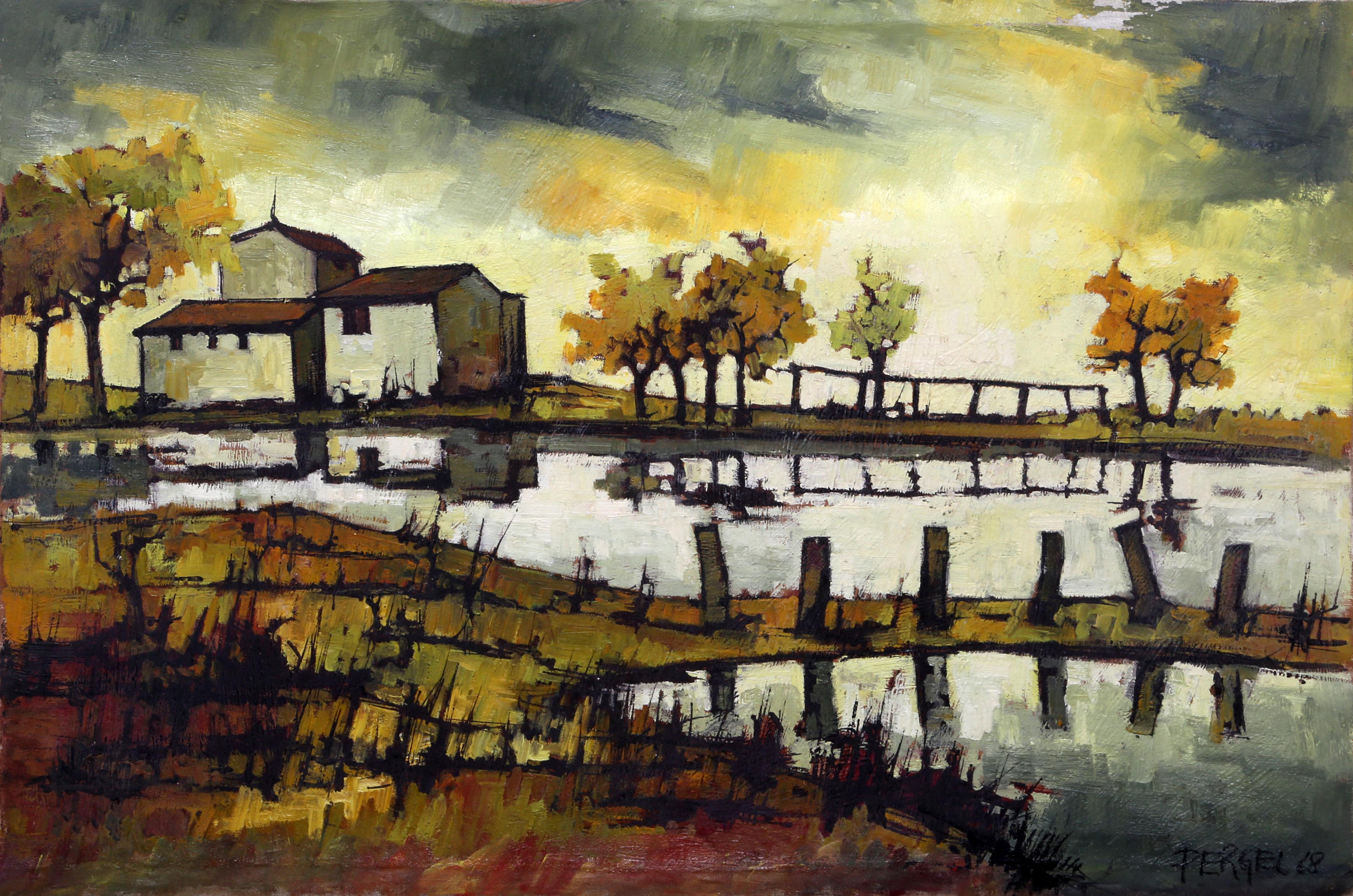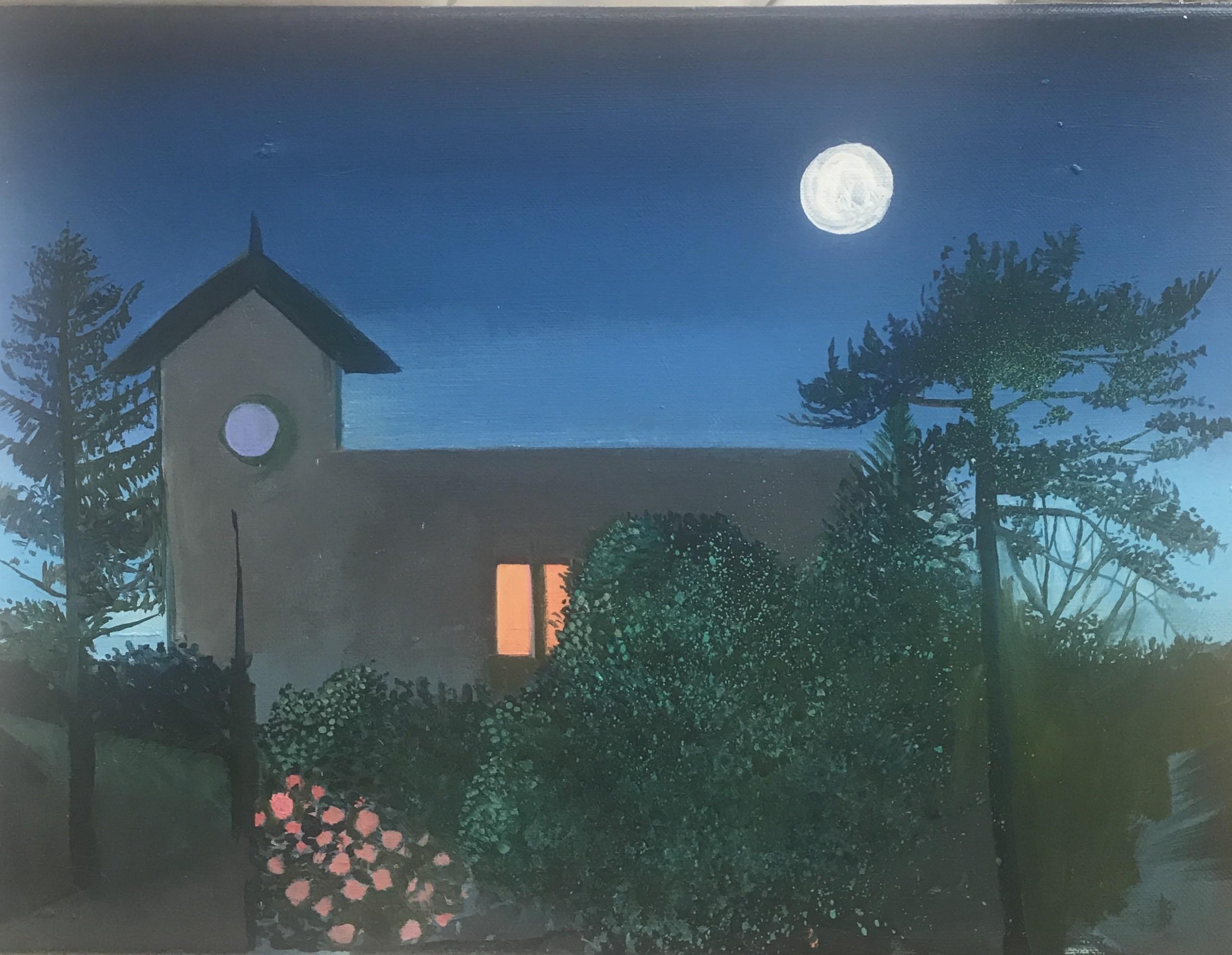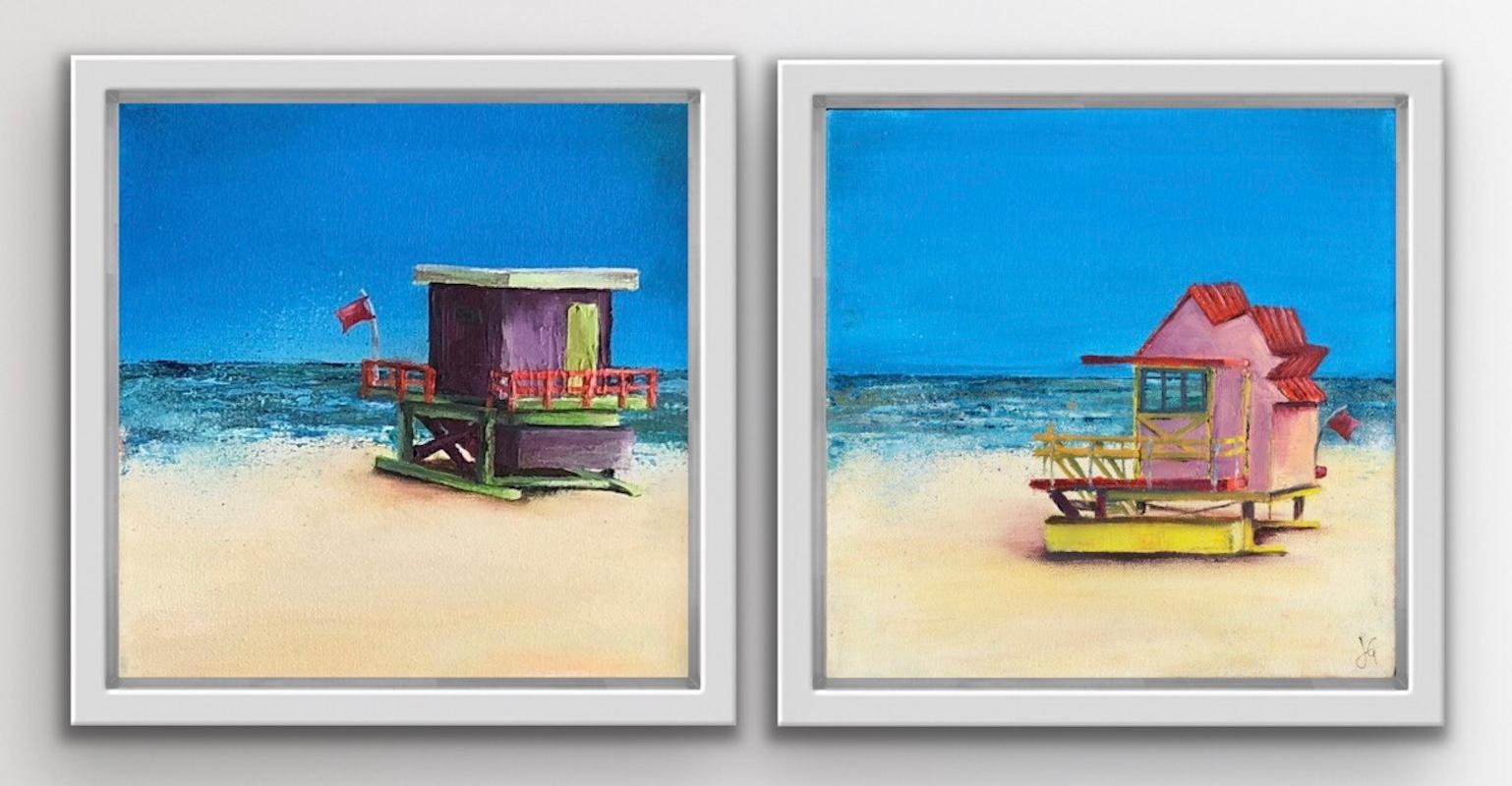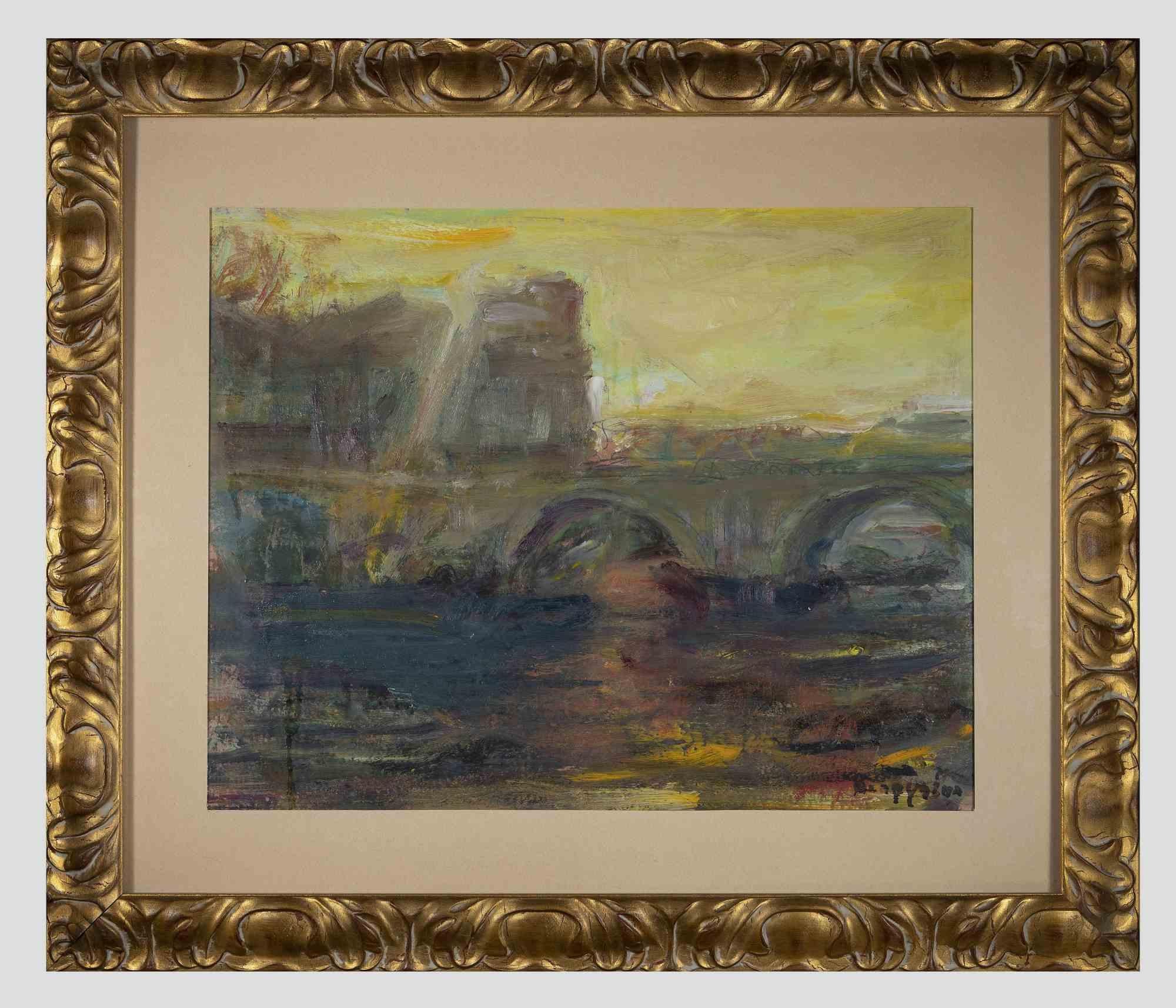Gershon Benjamin"Autumn at Ocean Grove"c. 1960
c. 1960
About the Item
- Creator:Gershon Benjamin (1899, American)
- Creation Year:c. 1960
- Dimensions:Height: 28 in (71.12 cm)Width: 36 in (91.44 cm)
- Medium:
- Period:
- Condition:
- Gallery Location:Lambertville, NJ
- Reference Number:
Gershon Benjamin
In a body of work that spans seven decades, obscure American modernist artist Gershon Benjamin explored a varied range of tone, style and subject matter in watercolor, oil and charcoal. Not one to resign himself to a single trademark theme, Benjamin focused on an eclectic array of subjects. His paintings included landscapes, portraits, still lifes and urban scenes.
Benjamin was born in Romania just before the turn of the 20th century. His family moved to Montreal in 1901 to escape ethnic persecution. At 10, Benjamin began studying art at the Canadian Council of Arts and Manufacturers, in Quebec. When he was 12, the Royal Canadian Academy admitted Benjamin.
In 1923, Benjamin moved to New York City, where he secured a night job in the art department of The Sun newspaper. He also enrolled in the Art Students League, where he learned engraving from the notable lithographer Joseph Pennell and drawing from illustrator John Sloan.
Benjamin found inspiration in the work of Pablo Picasso and Paul Cézanne. He depicted urban life in meditative Expressionist paintings that later drew comparisons to the Ashcan School — Benjamin painted scenes of New York City’s blocky skyline, elevated subway trains, empty streets at dawn and the Brooklyn Bridge as he saw them on his way home from his night shift at the newspaper.
In New York, Benjamin forged friendships with creative people who were as in love with art as he was and painted with them in Gloucester, Massachusetts, during the city’s hot summers. A number of his acquaintances found a fair amount of fame — including artists Mark Rothko, Raphael Soyer and Milton Avery — whereas Benjamin sought none. And when artists of the era in Manhattan and elsewhere began to work in the style that would become known as Abstract Expressionism, Benjamin continued to create representational art. He remained largely obscure throughout his career, declining to promote or market his still lifes, landscapes and portraiture.
Benjamin's works are held in a number of private and public collections including the Pennsylvania Academy of Fine Arts and the Ulrich Museum of Art.
Find original Gershon Benjamin paintings on 1stDibs.
- ShippingRetrieving quote...Ships From: Lambertville, NJ
- Return PolicyThis item cannot be returned.
- "Summer Splendor"By Gershon BenjaminLocated in Lambertville, NJJim’s of Lambertville is proud to offer this artwork by: Gershon Benjamin (1899 - 1985) An American Modernist of portraits, landscapes, still lives, and the urban scene, Gershon ...Category
1970s Modern Landscape Paintings
MaterialsCanvas, Oil
- "Grand Canyon"By Gershon BenjaminLocated in Lambertville, NJJim’s of Lambertville is proud to offer this artwork by: Gershon Benjamin (1899 - 1985) An American Modernist of portraits, landscapes, still lives, and the urban scene, Gershon ...Category
20th Century Modern Landscape Paintings
MaterialsCanvas, Oil
- "The Canal"By Edward Willis RedfieldLocated in Lambertville, NJJim’s of Lambertville is proud to offer this artwork. Signed lower left. Complemented by a hand carved and gilt frame. Illustrated in "Edward Redfield: Just Values and Fine Seeing" by Constance Kimmerle and the Pennsylvania Academy of the Fine Arts's Exhibition of Paintings by Edward Redfield (April 17 to May 16, 1909) brochure Edward Willis Redfield (1869 - 1965) Edward W. Redfield was born in Bridgeville, Delaware, moving to Philadelphia as a young child. Determined to be an artist from an early age, he studied at the Spring Garden Institute and the Franklin Institute before entering the Pennsylvania Academy from 1887 to 1889, where he studied under Thomas Anshutz, James Kelly, and Thomas Hovenden. Along with his friend and fellow artist, Robert Henri, he traveled abroad in 1889 and studied at the Academie Julian in Paris under William Bouguereau and Tony Robert-Fleury. While in France, Redfield met Elise Deligant, the daughter of an innkeeper, and married in London in 1893. Upon his return to the United States, Redfield and his wife settled in Glenside, Pennsylvania. He remained there until 1898, at which time he moved his family to Center Bridge, a town several miles north of New Hope along the Delaware River. Redfield painted prolifically in the 1890s but it was not until the beginning of the twentieth century that he would develop the bold impressionist style that defined his career. As Redfield’s international reputation spread, many young artists gravitated to New Hope as he was a great inspiration and an iconic role model. Edward Redfield remained in Center Bridge throughout his long life, fathering his six children there. Around 1905 and 1906, Redfield’s style was coming into its own, employing thick vigorous brush strokes tightly woven and layered with a multitude of colors. These large plein-air canvases define the essence of Pennsylvania Impressionism. By 1907, Redfield had perfected his craft and, from this point forward, was creating some of his finest work. Redfield would once again return to France where he painted a small but important body of work between 1907 and 1908. While there, he received an Honorable Mention from the Paris Salon for one of these canvases. In 1910 he was awarded a Gold Medal at the prestigious Buenos Aires Exposition and at the Panama-Pacific Exposition of 1915 in San Francisco, an entire gallery was dedicated for twenty-one of his paintings. Since Redfield painted for Exhibition with the intent to win medals, his best effort often went into his larger paintings. Although he also painted many fine smaller pictures, virtually all of his works were of major award-winning canvas sizes of 38x50 or 50x56 inches. If one were to assign a period of Redfield’s work that was representative of his “best period”, it would have to be from 1907 to 1925. Although he was capable of creating masterpieces though the late 1940s, his style fully matured by 1907 and most work from then through the early twenties was of consistently high quality. In the later 1920s and through the 1930s and 1940s, he was like most other great artists, creating some paintings that were superb examples and others that were of more ordinary quality. Redfield earned an international reputation at a young age, known for accurately recording nature with his canvases and painting virtually all of his work outdoors; Redfield was one of a rare breed. He was regarded as the pioneer of impressionist winter landscape painting in America, having few if any equals. Redfield spent summers in Maine, first at Boothbay Harbor and beginning in the 1920s, on Monhegan Island. There he painted colorful marine and coastal scenes as well as the island’s landscape and fishing shacks. He remained active painting and making Windsor style furniture...Category
Early 1900s American Impressionist Landscape Paintings
MaterialsCanvas, Oil
- "In Port"By Edward Willis RedfieldLocated in Lambertville, NJJim’s of Lambertville is proud to offer this artwork by: Edward Willis Redfield (1869 - 1965) Edward W. Redfield was born in Bridgeville, Delaware, moving to Philadelphia as a young child. Determined to be an artist from an early age, he studied at the Spring Garden Institute and the Franklin Institute before entering the Pennsylvania Academy from 1887 to 1889, where he studied under Thomas Anshutz, James Kelly, and Thomas Hovenden. Along with his friend and fellow artist, Robert Henri, he traveled abroad in 1889 and studied at the Academie Julian in Paris under William Bouguereau and Tony Robert-Fleury. While in France, Redfield met Elise Deligant, the daughter of an innkeeper, and married in London in 1893. Upon his return to the United States, Redfield and his wife settled in Glenside, Pennsylvania. He remained there until 1898, at which time he moved his family to Center Bridge, a town several miles north of New Hope along the Delaware River. Redfield painted prolifically in the 1890s but it was not until the beginning of the twentieth century that he would develop the bold impressionist style that defined his career. As Redfield’s international reputation spread, many young artists gravitated to New Hope as he was a great inspiration and an iconic role model. Edward Redfield remained in Center Bridge throughout his long life, fathering his six children there. Around 1905 and 1906, Redfield’s style was coming into its own, employing thick vigorous brush strokes tightly woven and layered with a multitude of colors. These large plein-air canvases define the essence of Pennsylvania Impressionism. By 1907, Redfield had perfected his craft and, from this point forward, was creating some of his finest work. Redfield would once again return to France where he painted a small but important body of work between 1907 and 1908. While there, he received an Honorable Mention from the Paris Salon for one of these canvases. In 1910 he was awarded a Gold Medal at the prestigious Buenos Aires Exposition and at the Panama-Pacific Exposition of 1915 in San Francisco, an entire gallery was dedicated for twenty-one of his paintings. Since Redfield painted for Exhibition with the intent to win medals, his best effort often went into his larger paintings. Although he also painted many fine smaller pictures, virtually all of his works were of major award-winning canvas sizes of 38x50 or 50x56 inches. If one were to assign a period of Redfield’s work that was representative of his “best period”, it would have to be from 1907 to 1925. Although he was capable of creating masterpieces though the late 1940s, his style fully matured by 1907 and most work from then through the early twenties was of consistently high quality. In the later 1920s and through the 1930s and 1940s, he was like most other great artists, creating some paintings that were superb examples and others that were of more ordinary quality. Redfield earned an international reputation at a young age, known for accurately recording nature with his canvases and painting virtually all of his work outdoors; Redfield was one of a rare breed. He was regarded as the pioneer of impressionist winter landscape painting in America, having few if any equals. Redfield spent summers in Maine, first at Boothbay Harbor and beginning in the 1920s, on Monhegan Island. There he painted colorful marine and coastal scenes as well as the island’s landscape and fishing shacks. He remained active painting and making Windsor style furniture...Category
Early 1900s American Impressionist Landscape Paintings
MaterialsCanvas, Oil
- "Cedar Hill"By George William SotterLocated in Lambertville, NJJim’s of Lambertville is proud to offer this artwork. Signed lower right. Original Period Newcomb Macklin Frame George William Sotter (1879 - 1953) Born in Pittsburgh on September 25, 1879, Sotter began his art education with local teachers and with Henry G. Keller, who had studied in various German academies. Keller, known for his superb, atmospheric watercolors, taught at the Cleveland School of Art but Sotter studied with him in Pittsburgh. Later Sotter would exhibit between 1903 and 1937 at the Pennsylvania Academy of the Fine Arts. His works were also shown at the Corcoran Gallery (1912-23), the Carnegie International (1901-26), the National Academy of Design (1913 and 1921), and at the Art Institute of Chicago (1911-27). In 1915, Sotter exhibited four works at the Panama-Pacific International Exposition in San Francisco, where he won a silver medal. Sotter was known mainly as a stained-glass artist; his work may be seen from New York City to Salt Lake City. Around a dozen craftsmen worked under him for these commissions. Sotter spent the summer of 1902 with Pennsylvania impressionist Edward Redfield in Boothbay Harbor, Maine. Between 1910 and 1919, Sotter taught at the Carnegie Institute of Technology. His paintings often feature large areas of sky filled with clouds and he frequently painted winter night scenes, such as Moonlight, Bucks County (Beacon Hill Fine Art), a perfectly successful depiction of a quiet, moonlit landscape filled with twinkling stars. Star-studded skies, although rare in landscape painting, go back at least to 1600 when they appear in the oeuvre of Adam Elsheimer...Category
20th Century Abstract Impressionist Paintings
MaterialsCanvas, Oil
- "Solebury Valley"By William Langson LathropLocated in Lambertville, NJSigned lower right. Complemented by a period frame. William L. Lathrop (1859-1938) Deemed “Father of the New Hope Art Colony”, William Langson Lathrop was born in Warren, Illinois. He was largely self-taught, having only studied briefly with William Merritt Chase in 1887, at the Art Students League. Lathrop first moved east in the early 1880s, and took a job at the Photoengraving Company in New York City. While there, he befriended a fellow employee, Henry B. Snell. The two men became lifelong friends and ultimately, both would be considered central figures among the New Hope Art Colony. Lathrop's early years as an artist were ones of continuing struggle. His efforts to break through in the New York art scene seemed futile, so he scraped enough money together to travel to Europe with Henry Snell in1888. There he met and married an English girl, Annie Burt. Upon returning to New York, he tried his hand at etching, making tools from old saw blades...Category
1910s American Impressionist Landscape Paintings
MaterialsCanvas, Oil
- Paul Manes - Tagus, Painting 2006By Paul ManesLocated in Greenwich, CTPaul Manes was born May 4, 1948 in Austin, Texas. He began his professional career in New York City in the early 1980s. His art has been widely exhibited in America and Europe and hi...Category
2010s Contemporary Landscape Paintings
MaterialsCanvas, Paint, Oil
- Paul Manes - Untitled - Logs, Painting 2021By Paul ManesLocated in Greenwich, CTPaul Manes was born May 4, 1948 in Austin, Texas. He began his professional career in New York City in the early 1980s. His art has been widely exhibited in America and Europe and hi...Category
2010s Contemporary Landscape Paintings
MaterialsCanvas, Oil
- House on the Water, Oil Painting by Jacques PergelLocated in Long Island City, NYArtist: Jacques Pergel, French Title: House on the Water Year: 1968 Medium: Oil on Canvas, signed and dated lower right Size: 24 x 36 in. (60.96 x 91.44...Category
1960s Modern Landscape Paintings
MaterialsOil, Canvas
- Blue Mountains - 21st Century, Contemporary Figurative Painting, Gold, MountainsBy Chelsea DavineLocated in Barcelona, CataloniaOil, acrylic and gold leaf on canvas For centuries, artisans and artists have turned to gold leaf as a way to make their creations shimmer and shine. Also many contemporary artists ...Category
21st Century and Contemporary Contemporary Landscape Paintings
MaterialsGold Leaf
- L.A. Aerial #6By Pete KasprzakLocated in Los Angeles, CAPete Kasprzak’s passion for city life is expressed in his dynamic urban artworks. Kasprzak’s artworks express energy and life with animated brush strokes. He adds dynamic movement an...Category
21st Century and Contemporary Contemporary Landscape Paintings
MaterialsGesso, Canvas, Mixed Media, Oil
- Pink TacoBy Pete KasprzakLocated in Los Angeles, CAPete Kasprzak’s passion for city life is expressed in his dynamic urban artworks. Kasprzak’s artworks express energy and life with animated brush strokes. He adds dynamic movement an...Category
21st Century and Contemporary Contemporary Landscape Paintings
MaterialsGesso, Canvas, Mixed Media, Oil






